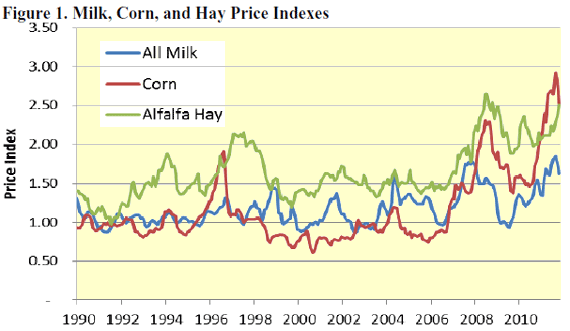



Dairy Margin Outlook: Production Increases
Expected domestic and global milk production increases, large heifer inventories, and economic instability provide bearish signals for 2012 milk prices, writes Kristen Schulte, University of Iowa.But stable global demand, decreased domestic product stocks, and favorable beef markets are bullish signals that can help stabilize milk prices. Moving into the end of the year, 2012 margins look bleak for dairy producers. Producers in Iowa and in the upper Midwest may benefit compared to other regions due to availability of feed and farm-raised feedstuffs in a time of increased commodity prices.
In Figure 1, prices for milk, corn, and hay in Iowa are compared, based on price indexes. A price index measures how a price changes over time based on a given starting point. Prices outlined below are measured using 1980 as a base year due to data availability. The all milk price, a weighted average of prices paid to producers from handlers, was used for the milk price. While market averages for Iowa were used for corn and alfalfa hay.

In October 2011, corn and alfalfa hay have increased 1.5 times the price level in 1980 while the all-milk price has only increased 0.63 from base price (1 is the base index level). When trend lines are placed on this graph, corn and milk indexes trend closely with corn surpassing milk in the past ten years. However, alfalfa hay price index takes a much sharper increase in value over time. This can be attributed to the hay market not being influenced by commodity markets like other feed stuffs, but producers should take note of the steadily increasing forage prices compared to other feedstuffs and milk prices.
Margin Management
The growth of separation between feed and milk indexes, outlook for feed prices to hold, and milk prices to soften creates the need for producers to evaluate milk pricing strategies, feed cost per cow, and related margins. Income over feed cost (IOFC) is one measure to evaluate profitability and operating margins. This measure as outlined below measures gross income from milk sales less feed cost on a per cow basis. The result is what a producer has left to pay all other operating and fixed costs. Feed costs represent about 35 to 50 percent of all costs to produce milk and are the most variable cost of producing milk; therefore, IOFC is a good measure to track profitability.
IOFC ($/cow/day) = Milk price/cwt. * Lbs. of milk/cow/day ÷ 100 – Feed cost/cow/day
Milk margin (MM) calculates IOFC on a per hundredweight basis as outlined below.
MM ($/cwt) = Milk price/cwt. – Feed cost/cow/day * 100 ÷ Lbs. of milk/cow/day
The CME group calculated IOFC at $9.97 for October 2011 and estimated November 2011 IOFC at $8.89 with the 10-year average IOFC at $9.09. Benchmarking is an important part of financial and margin analysis; however, one must compare apples to apples. It is recommended that producers calculate IOFC for their farm and track it over time to determine where their operation stands.
January 2012


